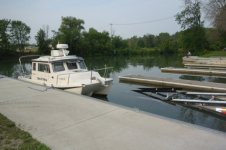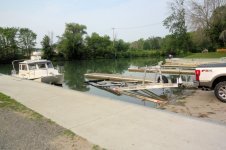A1A,
Scupper back seepage is annoying but usually due to heavy loads. Full gas tanks add 900 pounds. Three big guys in an aft corner will do it, or wind waves. Get 2” stoppers and plug them from the inside as needed.
Regarding ramps, agree you’d favor steep and deep. Because the sponsons have to ride on bunks ABOVE big trailer tires, the aft end of the boat may not start to float until the water over the ramp is 53” deep. Minor ramps may end before that happens. As a single handler, it may be very difficult to determine when this 9,000 lb boat is floating enough to be totally free of the bunks yet not pull you off the dock as it floats away in the wind and current.
Given your past boating experience, I’d consider an alternate method when the ideal situation Bob describes is not available. Pre-place your lines and fenders. Our bow lines lead back to a ‘locking cleat’ in the cockpit.
At the top of the ramp, I let out 2-4 feet of winch strap (still hooked to boat) but I don’t remove the safety chain until ready to launch. If the ramp is unexpectedly steep or deep and the boat slides back, it puts too much weight on the winch pawl to release it or winch it up. Board, start engines and push the boat up the trailer when that happens…helpful to have a buddy who can then release the winch strap. But at least the boat is not floating away with no one aboard.
Power off and power on to the trailer with a helper in the truck for the minor adjustments. It will still take practice to determine when the boat is in deep enough water that modest reverse engine thrust can pull it off the bunk friction and yet allow you to board from the bow trailer steps with winch and safety chain off while not inadvertently pushing the boat off the trailer. Raise engines enough that the thrust is straight back not downwards, say 1500-2000 RPM max. At the helm, reverse off the trailer and tie the boat up at the dock, then go park the rig.
For loading the boat on the trailer, again getting the trailer backed down to the best depth is key. The ‘centering cage’ helps guide the sponsons onto the bunks, but it won’t work if the trailer and cage are too deep/too far down the ramp.
For most ramps, we find the best trailer depth for launching is when the front wheel fenders are submerged 2-3 inches. I release the winch strap and start the engines. If 1500 RPM in Reverse isn’t enough to pull off the trailer, I signal Eileen (in the truck) to back the rig down another foot or so and the boat slides right off.
At our ramps, the best trailer depth for loading is with the forward part of the front fender awash to 1-2 inches ABOVE the water. This tends to ensure that the sponsons can start up the bunks with the inner cage keeping it straight. Look back as well as forward to keep the boat straight onto the trailer. This loads the forward portion of the boat about 80% up the trailer. I then signal Eileen to back down an additional foot or so; then much less RPM drama is needed to push it up to the bow stop barrier and ‘indicator’ kissing the bow rail.
Note that having a helper in the truck to do nothing more than back up another foot or so saves a lot of time vs the capt having to clamber back down the trailer ladder to the truck by himself. Also, no one is at the helm if the boat unexpectedly launches. Having a buddy along who can back down the truck helps save time and ensures you are at the helm to control the boat. Granted, for either launching or loading, if you have the trailer backed down to the ‘perfect’ depth it will slide right off and slide right on without this ‘two-step’ approach.
You need a ladder or steps on the trailer to get up on the boat deck. Even more important, for loading you need a bowstop position indicator, which is a trailer mounted ½ inch PVC removable piece with marks where the bow rail should kiss to avoid hitting the bowstop bar too hard (which you can’t see from the helm).
The boat launches and loads well in less time that it takes to read this. The first three years we had a poorly designed trailer that caused all kinds of misery. In 2015 we had a Float-On Bob Austin clone built and couldn't be happier with it.
You’ll find a method that works for you!
Best,
John




